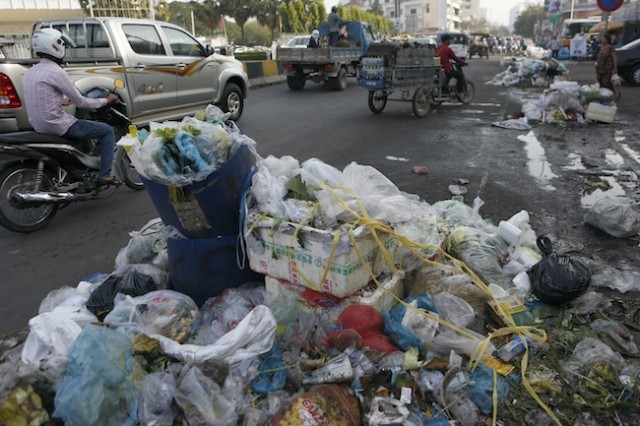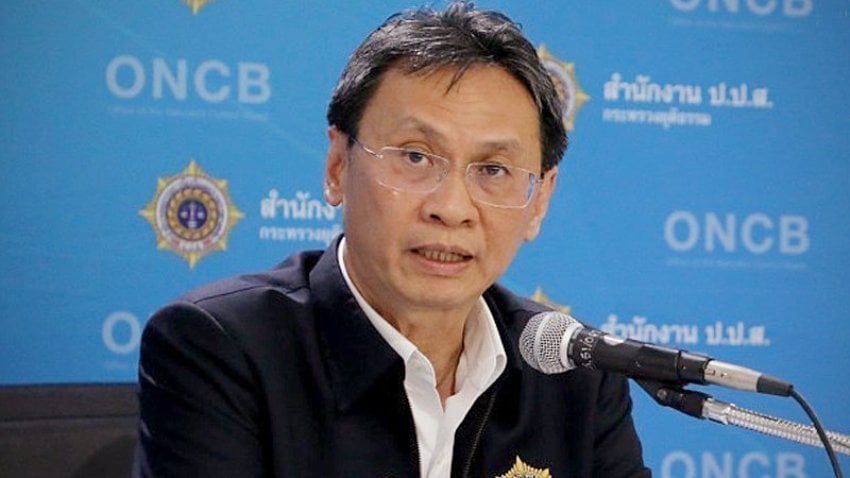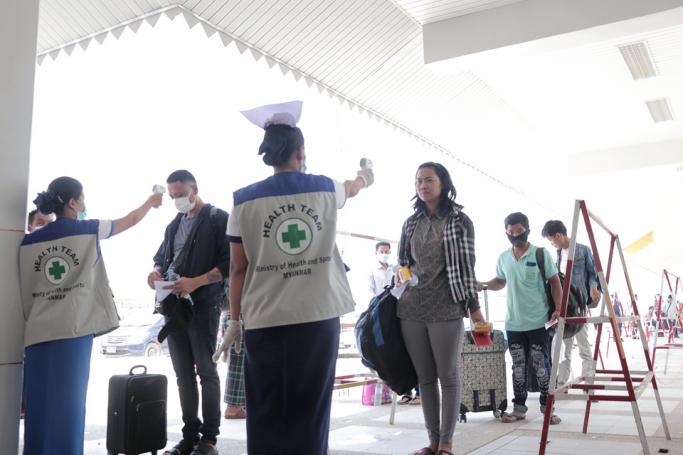The need for Cambodia to tackle its growing waste problem has been underscored by an announcement from the Ministry of Environment, who in November 2019, unveiled plans to introduce a sub-decree banning single-use plastics.
“I can’t tell you the exact date when it will be finished, but we are working on a sub-decree that will be completed as soon as possible,” the ministry’s spokesman, Neth Pheaktra said. He went on to say that the proposed ban — announced on Nov. 13, 2019 — would cover imports and the production of single-use plastics such as straws, spoons and cups, with an added focus on coffee shops, food vendors and supermarkets, as well as individuals.
Cambodia does not stand alone in the fight against plastic pollution. Greenpeace’s 2019 policy brief on Southeast Asia highlighted efforts made by Association of Southeast Asian Nations (ASEAN) member states, but noted the limitations of unilateral solutions to a global problem. While countries like Malaysia and Thailand have both laid out very concrete roadmaps that aim to phase out single-use plastics entirely, other ASEAN members have shown less commitment, with Cambodia introducing a small $0.10 charge for plastic bags in major supermarkets.
Having enjoyed rapid economic development, with almost a decade of annual Gross Domestic Product growth of 7 percent, Cambodia now faces a multi-faceted environmental crisis. Generating more than 10,000 tonnes of waste every day — more than 3.6 million tonnes a year — Cambodia’s consumption is only increasing, with the volume of waste rising by 10 percent annually. Phnom Penh alone generates some 3,000 tonnes of waste per day, of which about 20 percent is plastic. Daily waste production is estimated at 1,000 tonnes in Sihanoukville province and 300 tonnes in Siem Reap province. Less than 50 percent of all the Kingdom’s rubbish ends up in dumping grounds, the rest is either burned on the streets or set adrift in waterways.
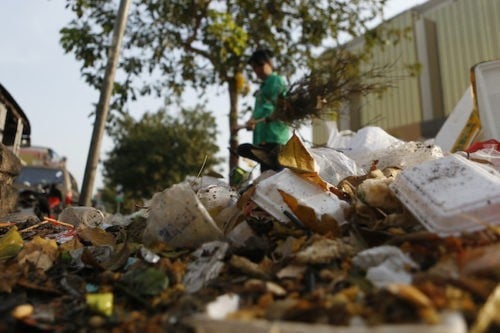
An Ecosystem under Threat
This then creates a new problem; plastic pollution in the Mekong – the Kingdom’s greatest natural resource. In 2018, researchers Christian Schmidt, Tobias Krauth and Stephen Wagner authored a study on plastic in 57 rivers. Published in Environmental Science and Technology, they identified the Yangtze, Yellow, Pearl, Amur, Mekong, Indus and Ganges rivers in Asia, along with the Niger and Nile rivers in Africa as carrying 93percent of the world’s plastic waste.
Each river analyzed was found to move between 0.47 million and 2.75 million tonnes of plastic into marine waters every year. The study found that rivers delivering the most plastic into seas and oceans were mainly located in middle-income countries in Asia.
“Eight million tonnes of plastic waste enters the world’s oceans. Most of it arrives by rivers including, of course, the Mekong,” says Nick Beresford, representative of the United Nations Development Program (UNDP) in Phnom Penh. “Toxic chemicals accumulate and pass through the food chain,” he said.
An Italian group known as the ACRA Foundation is trying to combat plastic bag waste in Cambodia. It notes that plastic is broken down into particles that are mixed with water and eaten by fish. The particles can be found in humans as they drink water or eat fish with the debris.
“Since fish comprises more than 60 percent of the protein intake for rural Cambodians, this is an important issue,” Beresford said.
The Mekong River Commission (MRC) comprises the four countries in the Lower Mekong Basin — Cambodia, Laos, Thailand and Vietnam. The MRC secretariat in Vientiane told Thmey Thmey that “Cambodian households use ten times more plastic than their counterparts in more developed economies, and plastic has become a challenge in an increasingly prosperous Laos.” The Mekong also includes China and Myanmar in the Upper Mekong Basin.
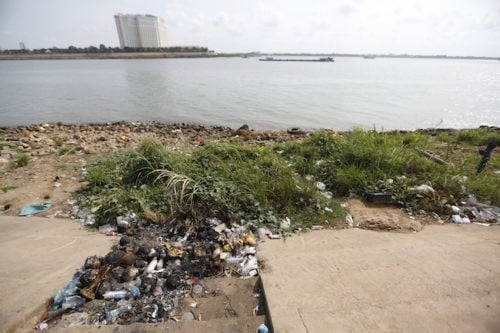
In February 2020, Laos played host to the MRC Secretariat and the United Nations Environment Programme (UNEP) Regional Office for Asia and the Pacific, where some 50 governmental representatives and university researchers from Cambodia, Laos, Thailand and Vietnam presented assessment methodologies for a 10-month study into plastic debris and its sources across the Mekong.
“That 2017 study was like a catalyst,” notes Meas Sopheak, the MRC’s press officer.
“This year the MRC is starting to review the status and legal aspects of plastic management in Cambodia, Laos, Thailand and Vietnam. Results from the review and those from this UNEP-led project will help inform what plans MRC has to make for the next five years,” he said.
Limited Understanding of the Impact
Set to conclude in March 2020, the UNEP project CounterMEASURE has received $1.1 million from the Japanese government and aims to provide the intergovernmental agency with concrete data and subsequent policy recommendations to address plastic pollution in both the Mekong and the Ganges rivers.
“There has not been any comprehensive study on plastic pollution in the Mekong – neither source nor impact,” explains Kakuko Nagatani-Yoshida, UN Environment Programme’s Regional Coordinator for Chemicals, Waste and Air Quality, adding that the purpose of CounterMEASURE is to plug this particular knowledge gap.
With the UNEP’s findings set to be published in May 2020, Nagatani-Yoshida hopes that this study will provide insights into the pollutants affecting the Mekong.
“They will provide a snap shot on plastic pollution along the Mekong. That said, determining a trend on improvement or deterioration will require a monitoring over a longer time frame. Hopefully we will be able to do this with the Mekong River Commission in the future. Knowing the rapid growth of plastic production in the region and worldwide, we already know that it will take drastic measures to bend the curve on plastic pollution,” she said.
She goes on to explain how new technologies and techniques have allowed the UNEP to gather data on plastic pollution, including the adoption of geographic information systems, a novel Japanese invention that can detect microplastics with minimal equipment and drone imaging that is scanned with machine learning algorithms that help her and her team to determine the concentration and make-up of plastic pollution.
“In addition to all of these technologies, the project also undertakes traditional surveys to log and categorize plastic pollution at sites around the Mekong. All of these, when synthesized, give us a good overview of exactly what types of plastic are entering the Mekong, and where. That will allow us to prescribe the best remedies for the problem from a policy point of view,” Nagatini-Yoshida explains.
In Cambodia’s coastal waters, research by the National University of Singapore has noted that bottles are a major part of plastic waste in Sihanoukville province’s Koh Rong archipelago — along with food packaging, disposable cutlery, straws and fishing gear.
This is just one of the hidden costs of the Kingdom’s economic boom, but now as Cambodia struggles to find the balance between tradition and modernity, between conservation and development, the question remains as to how it will rein in its waste problem.
The Cost of Cambodia’s Café Culture
One of the more ubiquitous polluters of plastic is the immense volume of coffee consumed across the country. From street vendors to local café chains, the plastic waste generated is staggering. Brown, a popular local coffee chain, has 18 branches in Phnom Penh and two in Siem Reap. Thailand’s Amazon Café chain has 100 outlets in Phnom Penh, six in Siem Reap and five in Sihanoukville.
Between them, the two chains go through an estimated 52,000 plastic cups a day — about 8,000 for Brown and 44,000 for Amazon. A further 5,000 cups are estimated to be used daily by Coffee Today, which has 17 branches in Phnom Penh, and Mobile Coffee, which has seven outlets.
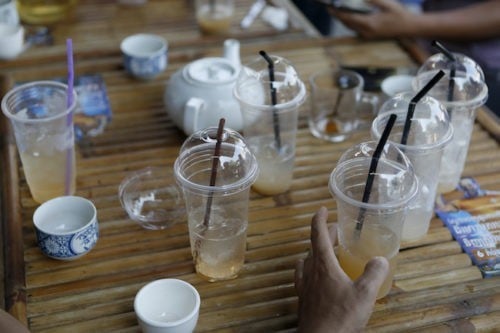
Chea Socheat, a 23-year-old student, says he drinks more than 10 cups of coffee a month but doesn’t plan to reduce using plastic. “I never throw my plastic outside a bin,” he said. “But I don’t have any plans to cut down my plastic as it’s the easy way of living. I don’t want to make myself stressed.”
Oem Srey Mech, a 24-year-old worker in Phnom Penh, says she has group meetings with coffee in plastic cups at Brown every weekend. “I don’t want to make myself too busy by carrying a lot of things on my back like renewable bottles as there is a lot of stuff with me already,” she said.
Beresford said the UNDP had not yet studied plastic waste from coffee shops, but noted that a single order contained multiple plastic items. “There is a plastic cup, a lid, and sometimes a straw, and a bag. All of these are single-use items which are thrown away almost immediately,” he said.
Brand manager of Brown Coffee and Bakery chain, Chem Srey Oeun believes that the chain will be equipped for the sub-decree, stating that the brand supports a ban on single-use plastics.
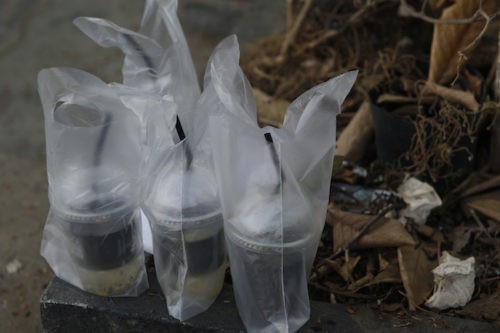
“We’re also in the process of studying and testing the alternatives for the remaining materials that are under single-use plastic,” she said, adding that Brown is looking into their suppliers and environmentally-friendly alternatives to single-use plastics that retain the quality customer experience the brand is known for. Ceramic mugs are already a part of the brand’s merchandise, she said, noting that Brown has taken some measures to reduce plastic waste.
Street Vendors and the Love of Plastic
Street vendors account for a large portion of plastic waste, given their accessibility and cheaper prices — largely attributed to their use of plastic. Anna Lim, operations officer at “sustainable cafe” Lot 369, said plastic was often cheaper.
“Most businesses in Cambodia are very small and cannot always afford suitable alternatives,” she said.
Street vendor Dalis, near Boeung Keng Kang market in Phnom Penh, says she sells 100 plastic cups of drinks a day if business is good. For Nary, a small street café owner near Toul Toem Pong Market, says her customers “don’t really like glass cups. They usually request plastic cups because they are more convenient to take away,” she said, adding that customers feel they get more volume in plastic cups.
According to Sandy Kotan, CEO of ecofriendly packaging company Only One Planet, recommends getting a reliable production of banana leaf packaging. This, she said, used to be popular until plastic became the mainstay of packaging in Cambodia.
Kotan herself has tried on three occasions to popularize the packaging among microbusinesses. “When I first started this I started asking around and asking why people stopped doing that. And the answer is just convenience”.
Banana leaf packaging lasts only three days and requires more work to create, whereas Styrofoam lacks an expiry date or time to make, according to Kotan’s findings. However, the banana and lotus leaves are possible alternatives for the informal sector as they are even less expensive than styrofoam, Kotan explained.
Will Legislation Be Effective?
“This is a very critical time,” At Sotheavy, Founder of environmental campaign Think Plastic stated. “We have created so much trash and we don’t have a good waste management system,” she said, but added that she sees the tables are turning.
After the sub-decree had been announced last year Think Plastic posted a video to gage public response to the ban. So far, the results have been positive according to Sotheavy.
“I think it will help a lot. If single-use items are being banned, there will no longer be plastic items being thrown into waterways or on the streets, so it will be a huge help, but it depends on the alternatives available,” she said.
“We have to wait and see what actions they [the government] will take next,” Sotheavy continued.
For example, the 2015 sub-decree on the management of urban garbage and solid waste management bans people not being responsible for their own trash, but Sotheavy says despite this, little implementation has followed in five years.
“From what I hear they have to give people time to understand that there is a law, there is a sub-decree. When people realize that there is a ban and a fine, they can implement this sub-decree and create a task force. It might be similar steps, I’m not sure – I personally support the idea and am curious to see what happens,” Sotheavy said.
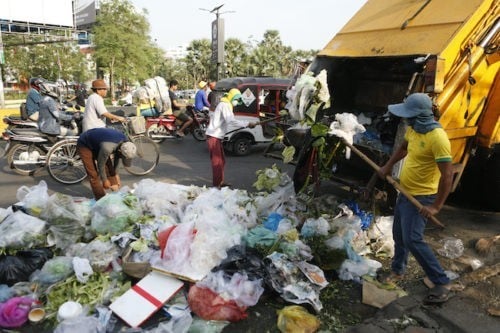
Holistic Solutions Needed
For many, a plastic ban is not enough and more holistic approaches are needed, as raised by the United Nations Environment Programme (UNEP) in November 2019.
“Southeast Asia is a primary source and victim of plastic, where it is choking seas and threatening ecosystems and livelihoods,” said Kakuko Nagatani-Yoshida, UNEP’s regional coordinator for chemicals and waste. “If we want to solve the marine litter problem globally, we have to solve it in this region.”
Sihanoukville faces serious waste-management issues that extend beyond single-use plastics. The province’s garbage company has only 85 trucks to transport trash to a local landfill – meaning the province lacks capacity to deal with its waste outputs. As such, garbage flows freely into the sea through sewers after heavy rain.
Provincial Governor Kuoch Chamroeun says garbage in the city has been growing at an annual rate of up to 15 percent amid rapid development, much of which has been funded by Chinese foreign direct investment. In 2015, Sihanoukville was producing as little as 100 tonnes of waste per day, now it’s creating over 1,000 tonnes daily.
Chamroeun said the local garbage company plans to add 80 more trucks soon, but couldn’t specify when. “We also face problems transporting the waste because of damaged roads and traffic jams,” the governor said, adding that severe traffic jams limit the garbage trucks to one trip per day.
A report by an EU-funded project to reduce plastic bag waste found that low or middle-income households often segregate recyclable waste such as aluminum cans, but that “awareness of a problem does not necessarily translate into desired action,” it said, noting a need for systems that support positive actions. Challenges include the lack of proper collection, treatment infrastructure, technical training and effective waste-management policies.
Changing Behavior
“Public perception is the biggest challenge, the coffee shops that think plastic cups are great to sell branded products… It’s going to take a major shift in consumerism,” Only One Planet CEO Sandy Kotan explained, adding that popular Cambodian wisdom dictates that plastic is inherently clean and hygienic.
“The government will not be successful if the people don’t support it. It’s happening a lot, especially with university students, they’re onboard and supportive of it…” said Kotan, but admits that for many, old habits die hard.
For Lot 369’s Lim, there is no quick-fix solution. “It takes a lot of time to change people’s behavior. Businesses can introduce small things to make a big difference, it’s easy to simply replace some products for other more environmentally-friendly alternatives.”
Lot 369 uses “alternatives to single-use plastic wherever possible” and “the same ingredients across different dishes” to limit food waste, Lim said. She also highlighted the importance of partnering with others to get assistance for things like composting food waste.
Juliette Gilt, from Clean Green Cambodia, says the government should offer incentives to companies reducing their plastic waste and impose harsher penalties on those who pollute rivers, arguing that a single-use plastic ban would force people to look for alternatives. She also called upon the government to “ensure that there is a curriculum about environment and plastic in schools.”
This is already in place through a trial project run by the UNDP – Climate Change Action Plan for the Education Sector 2014-2018 saw the UNDP introduce climate change curricula for Cambodian schools, as well as teacher training programs, eco-schools initiatives and the promotion of climate change research at six local universities. With the trial run regarded a success, the UNDP expects to expand this project in the coming years.
A Growing Movement
In March 2019 a separate group known as Trash Youth started collecting trash in Phnom Penh.
Trash Youth leader San Dara Vit said individuals from neighborhoods “came to join themselves” after the group was set up. “I didn’t educate them much, I just changed their mindset,” he said. “We are trying to build a team.”
The group meanwhile makes and sells bamboo straws. “There are a lot of orders for bamboo straws right now,” San Dara Vit said. “What we want to do is reduce plastic and try to get people to reduce their garbage.” He said the group was working on the Ministry of Environment and the Ministry of Tourism to address the issue. “We are trying to push the government and corporations to find and fix the problem,” he said.
Garbage Youth member Chantha Rothey welcomed the proposed sub-decree, saying it would “help people earn income from producing bio-straws or eco-bags.” To fight plastic use “we need every individual involved,” she said. “This requires all stakeholders.”
In the same month online platform and campaign “Think Plastic”, was started by At Sotheavy. She was horrified at the magnitude of plastic litter when visiting a beach in Kep.
“Cambodians have a strong belief and bond with family. If you talk about the next generation, they will understand that they don’t want their kids or their grandkids to grow up with trash everywhere,” Sotheavy explained “This is how I feel people start to care, but sometimes people don’t know what to do or what steps they have to take to contribute to the change”.
Which is where education comes in for Sotheavy, who firmly believes that with enough information behavioral change will follow. In the past she had started challenges to her social media followers to “say no” to plastic.
What people used to tell her was strange has started to turn into a trend. “It is a small movement. One that always affects peoples’ communities first: their circle of friends and their family. It will have a big impact at some point, people don’t want to be left behind”.
This story is produced with reporting grant from Earth Journalism Network. The story is originally published by the Cambodianess and in Khmer-language Thmey Thmey.


